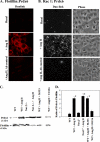Peroxiredoxin 6 phosphorylation and subsequent phospholipase A2 activity are required for agonist-mediated activation of NADPH oxidase in mouse pulmonary microvascular endothelium and alveolar macrophages
- PMID: 21262967
- PMCID: PMC3064221
- DOI: 10.1074/jbc.M110.206623
Peroxiredoxin 6 phosphorylation and subsequent phospholipase A2 activity are required for agonist-mediated activation of NADPH oxidase in mouse pulmonary microvascular endothelium and alveolar macrophages
Abstract
Peroxiredoxin 6 (Prdx6), a bifunctional enzyme with glutathione peroxidase and phospholipase A2 (PLA(2)) activities, participates in the activation of NADPH oxidase 2 (NOX2) in neutrophils, but the mechanism for this effect is not known. We now demonstrate that Prdx6 is required for agonist-induced NOX2 activation in pulmonary microvascular endothelial cells (PMVEC) and that the effect requires the PLA(2) activity of Prdx6. Generation of reactive oxygen species (ROS) in response to angiotensin II (Ang II) or phorbol 12-myristate 13-acetate was markedly reduced in perfused lungs and isolated PMVEC from Prdx6 null mice. Rac1 and p47(phox), cytosolic components of NOX2, translocated to the endothelial cell membrane after Ang II treatment in wild-type but not Prdx6 null PMVEC. MJ33, an inhibitor of Prdx6 PLA(2) activity, blocked agonist-induced PLA(2) activity and ROS generation in PMVEC by >80%, whereas inhibitors of other PLA(2)s were ineffective. Transfection of Prx6 null cells with wild-type and C47S mutant Prdx6, but not with mutants of the PLA(2) active site (S32A, H26A, and D140A), "rescued" Ang II-induced PLA(2) activity and ROS generation. Ang II treatment of wild-type cells resulted in phosphorylation of Prdx6 and its subsequent translocation from the cytosol to the cell membrane. Phosphorylation as well as PLA(2) activity and ROS generation were markedly reduced by the MAPK inhibitor, U0126. Thus, agonist-induced MAPK activation leads to Prdx6 phosphorylation and translocation to the cell membrane, where its PLA(2) activity facilitates assembly of the NOX2 complex and activation of the oxidase.
Figures









Similar articles
-
The phospholipase A2 activity of peroxiredoxin 6 modulates NADPH oxidase 2 activation via lysophosphatidic acid receptor signaling in the pulmonary endothelium and alveolar macrophages.FASEB J. 2016 Aug;30(8):2885-98. doi: 10.1096/fj.201500146R. Epub 2016 May 13. FASEB J. 2016. PMID: 27178323 Free PMC article.
-
p67(phox) terminates the phospholipase A(2)-derived signal for activation of NADPH oxidase (NOX2).FASEB J. 2013 May;27(5):2066-73. doi: 10.1096/fj.12-222133. Epub 2013 Feb 11. FASEB J. 2013. PMID: 23401562 Free PMC article.
-
Genetic inactivation of the phospholipase A2 activity of peroxiredoxin 6 in mice protects against LPS-induced acute lung injury.Am J Physiol Lung Cell Mol Physiol. 2019 Apr 1;316(4):L656-L668. doi: 10.1152/ajplung.00344.2018. Epub 2019 Jan 31. Am J Physiol Lung Cell Mol Physiol. 2019. PMID: 30702344 Free PMC article.
-
Peroxiredoxin 6: a bifunctional enzyme with glutathione peroxidase and phospholipase A₂ activities.Antioxid Redox Signal. 2011 Aug 1;15(3):831-44. doi: 10.1089/ars.2010.3412. Epub 2011 Mar 31. Antioxid Redox Signal. 2011. PMID: 20919932 Free PMC article. Review.
-
Structural and Functional Diversity of the Peroxiredoxin 6 Enzyme Family.Antioxid Redox Signal. 2024 May;40(13-15):759-775. doi: 10.1089/ars.2023.0287. Epub 2023 Sep 12. Antioxid Redox Signal. 2024. PMID: 37463006 Review.
Cited by
-
Role of Peroxiredoxins in Protecting Against Cardiovascular and Related Disorders.Cardiovasc Toxicol. 2020 Oct;20(5):448-453. doi: 10.1007/s12012-020-09588-0. Cardiovasc Toxicol. 2020. PMID: 32632849 Review.
-
Peroxiredoxin6 in Endothelial Signaling.Antioxidants (Basel). 2019 Mar 13;8(3):63. doi: 10.3390/antiox8030063. Antioxidants (Basel). 2019. PMID: 30871234 Free PMC article. Review.
-
Protection against LPS-induced acute lung injury by a mechanism-based inhibitor of NADPH oxidase (type 2).Am J Physiol Lung Cell Mol Physiol. 2014 Apr 1;306(7):L635-44. doi: 10.1152/ajplung.00374.2013. Epub 2014 Jan 31. Am J Physiol Lung Cell Mol Physiol. 2014. PMID: 24487388 Free PMC article.
-
S-glutathionylation of ion channels: insights into the regulation of channel functions, thiol modification crosstalk, and mechanosensing.Antioxid Redox Signal. 2014 Feb 20;20(6):937-51. doi: 10.1089/ars.2013.5483. Epub 2013 Aug 20. Antioxid Redox Signal. 2014. PMID: 23834398 Free PMC article. Review.
-
PECAM-1 and caveolae form the mechanosensing complex necessary for NOX2 activation and angiogenic signaling with stopped flow in pulmonary endothelium.Am J Physiol Lung Cell Mol Physiol. 2013 Dec;305(11):L805-18. doi: 10.1152/ajplung.00123.2013. Epub 2013 Sep 27. Am J Physiol Lung Cell Mol Physiol. 2013. PMID: 24077950 Free PMC article.
References
Publication types
MeSH terms
Substances
Grants and funding
LinkOut - more resources
Full Text Sources
Molecular Biology Databases
Research Materials
Miscellaneous

